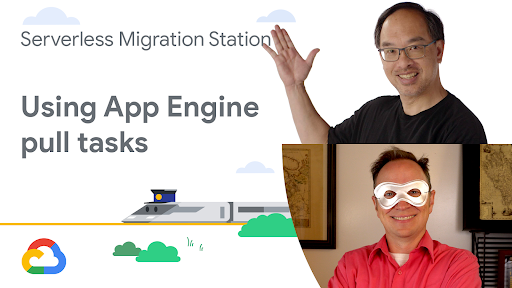Posted by Wesley Chun (@wescpy), Developer Advocate, Google Cloud
Introduction and background
The Serverless Migration Station mini-series helps App Engine developers modernize their apps to the latest language runtimes, such as from Python 2 to 3 or Java 8 to 17, or to sister serverless platforms Cloud Functions and Cloud Run. Another goal of this series is to demonstrate how to move away from App Engine's original APIs (now referred to as legacy bundled services) to Cloud standalone replacement services. Once no longer dependent on these proprietary services, apps become much more portable, making them flexible enough to:
- Run on 2nd generation App Engine runtimes
- Shift across to other serverless platforms, like Cloud Functions or Cloud Run (with or without Docker)
- Move to VM-based services like GKE or Compute Engine, or to other compute platforms
App Engine's Task Queue service provides infrastructure for executing tasks outside of the standard request-response workflow. Tasks may consist of workloads exceeding request timeouts or periodic tangential work. The Task Queue service provides two different queue types, push and pull, for developers to perform auxiliary work.
Push queues are covered in Migration Modules 7-9, demonstrating how to add use of push tasks to an existing baseline app followed by steps to migrate that functionality to Cloud Tasks, the standalone successor to the Task Queues push service. We turn to pull queues in today's video where Module 18 demonstrates how to add use of pull tasks to the same baseline sample app. Module 19 follows, showing how to migrate that usage to Cloud Pub/Sub.
Adding use of pull queues
In addition to registering page visits, the sample app needs to be modified to track visitors. Visits are comprised of a timestamp and visitor information such as the IP address and user agent. We'll modify the app to use the IP address and track how many visits come from each address seen. The home page is modified to show the top visitors in addition to the most recent visits:
 |
| The sample app's updated home page tracking visits and visitors |
When visits are registered, pull tasks are created to track the visitors. The pull tasks sit patiently in the queue until they are processed in aggregate periodically. Until that happens, the top visitors table stays static. These tasks can be processed in a number of ways: periodically by a cron or Cloud Scheduler job, a separate App Engine backend service, explicitly by a user (via browser or command-line HTTP request), event-triggered Cloud Function, etc. In the tutorial, we issue a curl request to the app's endpoint to process the enqueued tasks. When all tasks have completed, the table then reflects any changes to the current top visitors and their visit counts:
 |
| Processed pull tasks update the top visitors table |
Below is some pseudocode representing the core part of the app that was altered to add Task Queue pull task usage, namely a new data model class, VisitorCount, to track visitor counts, enqueuing a (pull) task to update visitor counts when registering individual visits in store_visit(), and most importantly, a new function fetch_counts(), accessible via /log, to process enqueued tasks and update overall visitor counts. The bolded lines represent the new or altered code.
![Adding App Engine Task Queue pull task usage to sample app showing 'Before'[Module 1] on the left and 'After' [Module 18] with altered code on the right](https://blogger.googleusercontent.com/img/b/R29vZ2xl/AVvXsEjRVGVYc9fl4xI9xUpOUaAwXup8p-wUf5nbKllG7OYJSVAYSPVCGw7DU8EbMoTE3kBBgVZiICFvsn_7fHP2oymA_1ASKBrAE2Qt8PzCGAAkK7_WnyvAIEMKQUrxP8FSz3tGykLrlu9nyluN5vgEPrWZrBqIAalCoRmos169g9m9NHz3cGqQyych9eEG/s1600/Screen%20Shot%202022-11-29%20at%205.19.28%20PM.png) |
| Adding App Engine Task Queue pull task usage to sample app |
Wrap-up
This "migration" is comprised of adding Task Queue pull task usage to support tracking visitor counts to the Module 1 baseline app and arrives at the finish line with the Module 18 app. To get hands-on experience doing it yourself, do the codelab by hand and follow along with the video. Then you'll be ready to upgrade to Cloud Pub/Sub should you choose to do so.
In Fall 2021, the App Engine team extended support of many of the bundled services to 2nd generation runtimes (that have a 1st generation runtime), meaning you are no longer required to migrate pull tasks to Pub/Sub when porting your app to Python 3. You can continue using Task Queue in your Python 3 app so long as you retrofit the code to access bundled services from next-generation runtimes.
If you do want to move to Pub/Sub, see Module 19, including its codelab. All Serverless Migration Station content (codelabs, videos, and source code) are available at its open source repo. While we're initially focusing on Python users, the Cloud team is covering other runtimes soon, so stay tuned. Also check out other videos in the broader Serverless Expeditions series.
